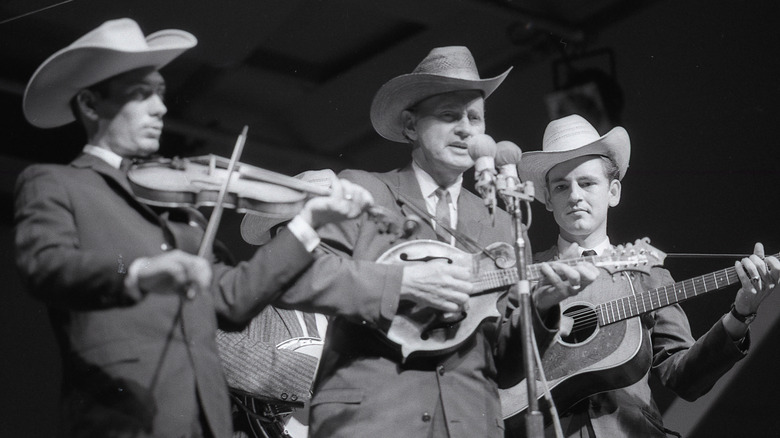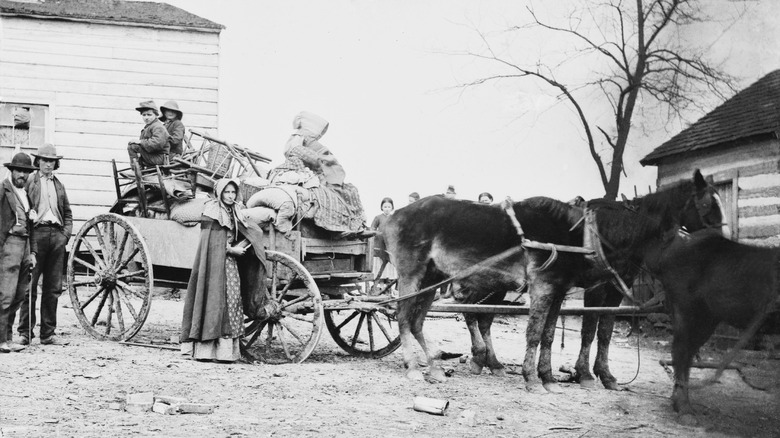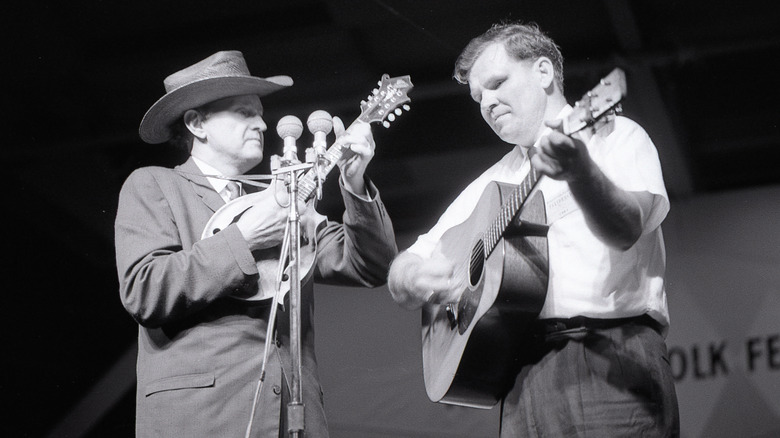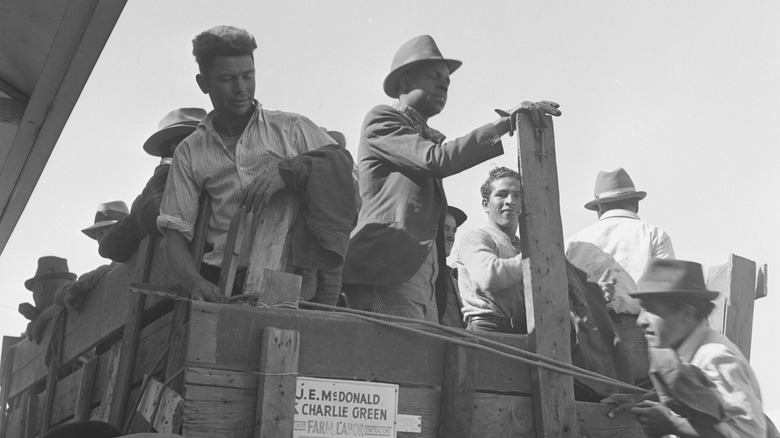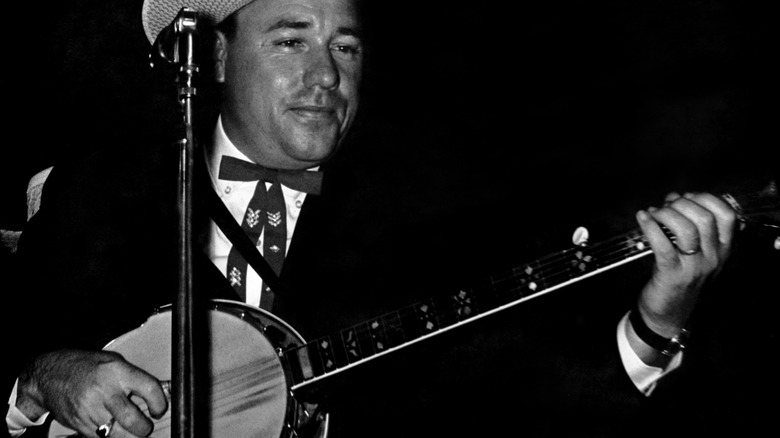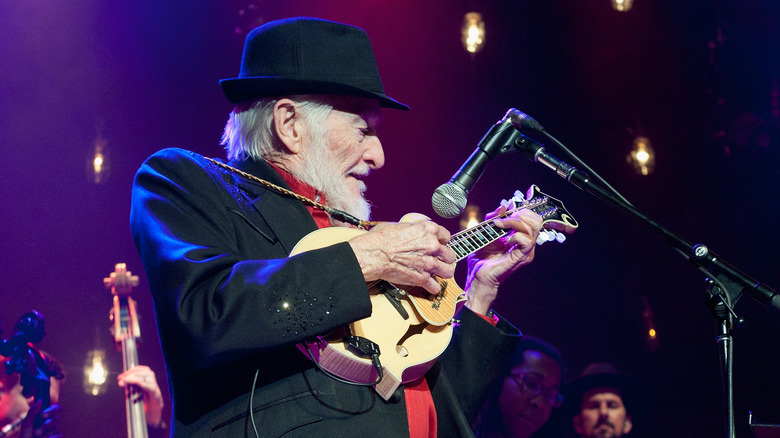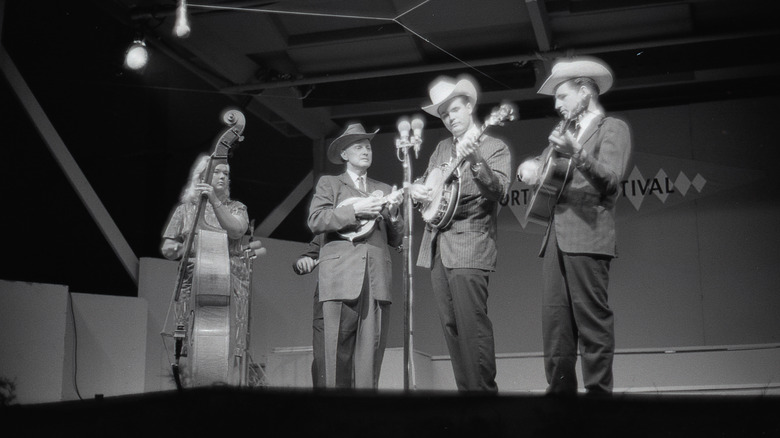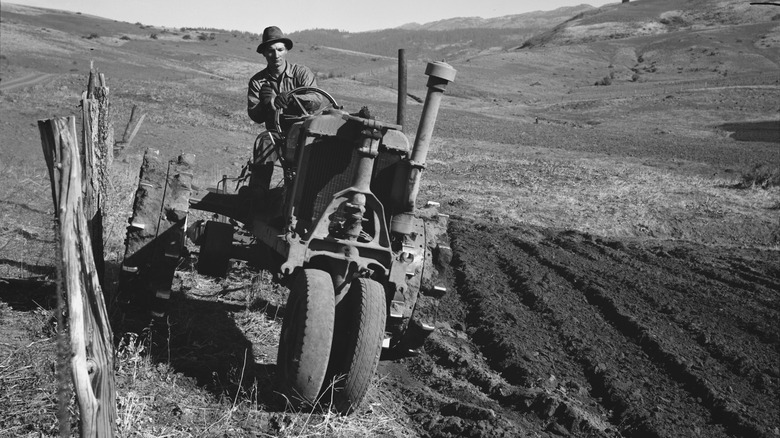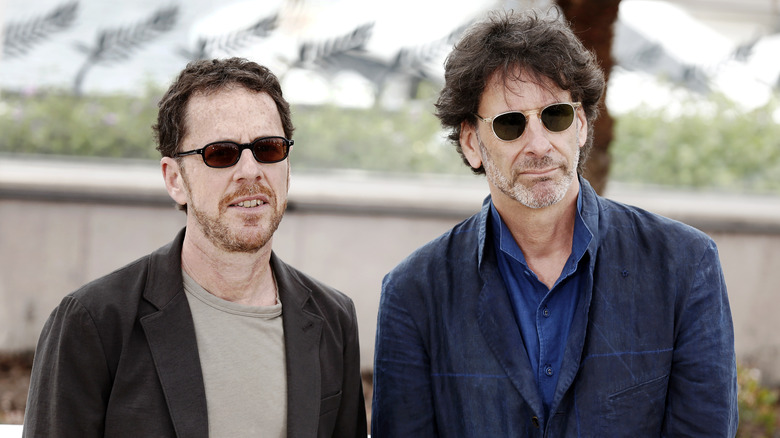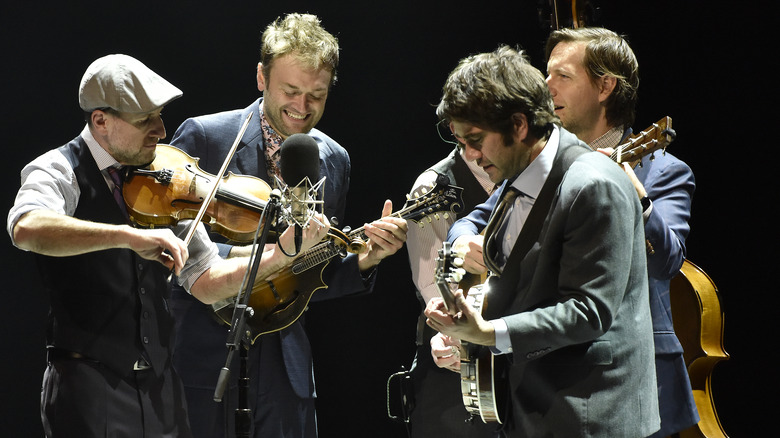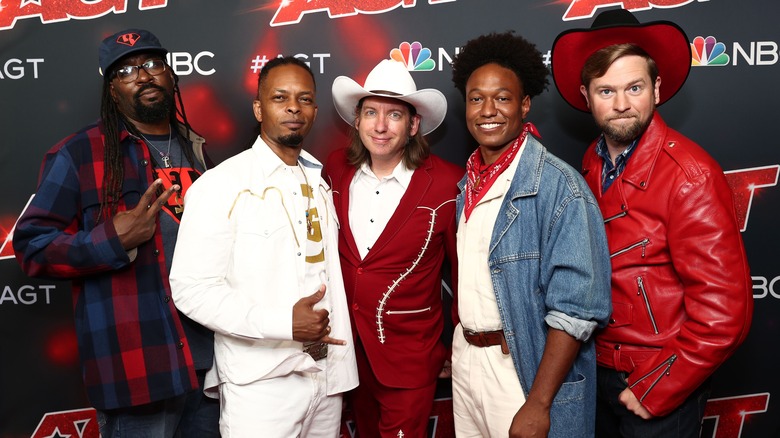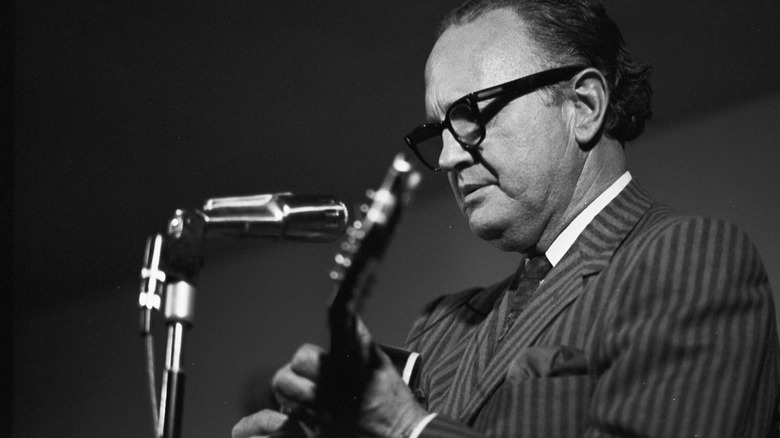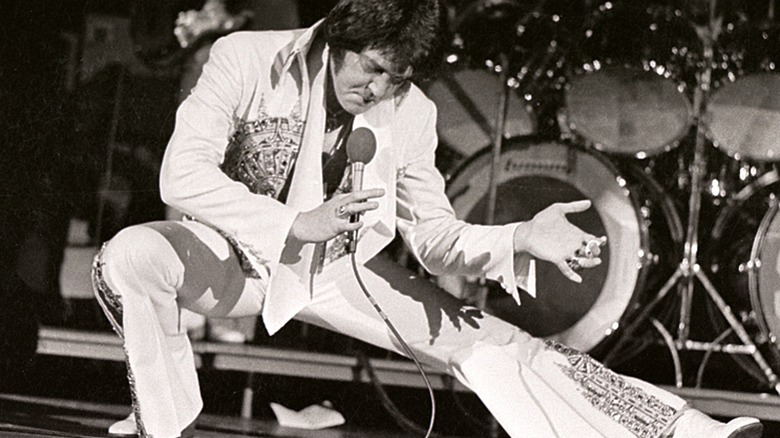The Bizarre History Of Bluegrass Music
In the 1930s, the Great Depression left millions of Americans without a job, and the countryside folk working the crops or helping build railroads suffered no less, per "High Lonesome: The Story of Bluegrass Music." Then, in 1939, as the Great Depression came to an end, World War II started, and Hitler took advantage of the Depression-related adversities to grow his horrific Nazi regime (via History). Still, amidst all this, playful fiddle and banjo tunes could be heard in every corner of the rural South. Perhaps not as hopeful as Franklin D. Roosevelt's "fireside chats" but just as lively, bluegrass music served as a great morale booster and bonding force for the poverty-stricken communities of the southern U.S.
But, although the bluegrass genre officially started with Bill Monroe's Blue Grass Boys (via Smithsonian Folkways), its roots date centuries back. And although it was once dismissed as "hillbilly music" and seemingly forgotten, today, it plays on; even pairing up with other genres like jazz (via NPR) and hip-hop (via The Guardian). That's right — there's so much more to bluegrass than meets the eye. Here's the bizarre (but pretty glorious) history of bluegrass music.
Its roots date back to the 1600s
According to the Bluegrass Heritage Foundation, bluegrass music dates back to 17th-century America and the very first Irish, Scottish, and English settlers. These families brought their violins across the ocean, as well as a few classic tunes from their native countries in the British Isles, such as "Soldier's Joy," "Fair and Tender Ladies," and "Building the Low Ground" (via "High Lonesome: The Story of Bluegrass Music"). Interestingly enough, these communities settled in the southern states: Tennessee, Kentucky, Virginia, and North and South Carolina. There they passed on a traditional musical style from Europe, but the lyrics were slowly adapted to their new surroundings.
British Isles settlers started writing lyrics that described their day-to-day affairs in the mountain villages, such as working for little cash or life (and problems) at home, per the Bluegrass Heritage Foundation. Needless to say (since "high lonesome" is an expression used to describe bluegrass), many of these lyrics also expressed the woes of living an itinerant life and/or being isolated in remote villages.
One classic bluegrass tune that chronicled both is "A Broken Tie." Its lyrics share: "My brother's gone to New York City / And I find myself in a corner of the west / My mom and daddy left their home and each other / Ten miles apart, more apart than the rest. / I'm singing songs of the poor and the homeless/ [...] A million miles apart with a broken tie" (via Bluegrass Lyrics).
Bluegrass is folk music on overdrive
In a simplistic way, bluegrass music can be understood as the stylistic baby of gospel and blues music. As the Bluegrass Heritage Foundation explains, this comes as a result of mostly white southern folk being inspired by the people of African origin from the Mississippi Delta region. However, Smithsonian Folkways gives a more ample account of bluegrass origins, citing country music, southern string band music, blues, and the British Isles traditions among the parents of the genre.
Nevertheless, this doesn't mean that bluegrass is simply a mix of the aforementioned. In fact, there are quite a few characteristics that make it stand out from the crowd: its fast pace and high-pitched tenor being at the forefront. Furthermore, the style, as well as the structure, of bluegrass songs is quite playful. As noted by Smithsonian Folkways, anyone can break into a solo at any time in bluegrass.
When an instrument (be it fiddle, mandolin, banjo, bass, or guitar) takes over the song, the other ones fall to the back. Bluegrass thus earned the description "folk music on overdrive." According to The Guardian, the expression was coined in an Esquire article back in 1959.
The etymology lies in a Kentucky plant
While some genre names are pretty self-explanatory (such as classical or country), when it comes to bluegrass, one might want an illustration of its etymology. The more obvious source for the genre's name is Bill Monroe's band, Bill Monroe and the Blue Grass Boys. Monroe himself is tied to the roots of bluegrass and, according to the Bluegrass Heritage Foundation, he's considered the father of bluegrass music.
So, because Monroe created the style that is associated with bluegrass in the 1940s and '50s (he and his brother Charles started playing as early as the 1920s on their family farm, together with their mother Malissa), his band came to stand as a source for the genre's name.
But why "bluegrass"? As per MasterClass, Kentucky, Monroe's home state, is called "The Bluegrass State" thanks to a particular native plant species (Poa pratensis). Before you ask, no, it's not blue, and it has since been introduced to Europe and Asia, too (via Britannica).
Industrial changes made it happen
Throughout the 1930s and '40s, significant industrial changes in the southern U.S. put white people from rural areas in contact with Black laborers (via "High Lonesome: The Story of Bluegrass Music"). If this hadn't happened, bluegrass would most likely have never been born. For the first time — as far as the southern U.S. is concerned — the two communities were exchanging musical ideas and styles. More specifically, white folk musicians were borrowing various Mississippi Delta styles and bringing them together.
These elements included the a cappella singing specific to plantation farmers and railroad workers, the banjo (also used on plantations since the 18th century), the syncopated rhythms pertaining to African culture, blues, and gospel sounds. All of these met traditional British Isles centuries-old tunes and formed the joyous, off-beat bluegrass style.
Bill Monroe himself was deeply inspired by guitarist and fiddler Arnold Shultz, who was the son of a former slave. According to Monroe in "High Lonesome," "A good gentleman named Arnold Shultz ... came up here on business ... One time he's up around Rosine and they wanted us to play for a square dance there, so Arnold played the fiddle and I played the guitar. And you might not believe this but this is right — we started around sunset in the evening and we were playing the next morning."
Per the Bluegrass Heritage Foundation, Shultz also created the thumb-style guitar technique that inspired Doc Watson and Merle Travis.
It wasn't bluegrass until Earl Scruggs joined the Blue Grass Boys
In the 1930s, Bill Monroe started playing with his brother Charlie as the Monroe Brothers (via the Bluegrass Heritage Foundation). After the brothers parted ways, Monroe created his famous band, the Blue Grass Boys. They made their first live appearance in 1939 at the Grande Ole Opry — in many ways, this is the official beginning of the bluegrass genre. However, according to BHF, many bluegrass fans point to December 1945 as the true start of bluegrass music.
This is the moment banjoist Earl Scruggs joined Bill Monroe and the Blue Grass Boys. As per Britannica, Scruggs was only 21 years old at the time; he was born on January 6, 1924, in North Carolina. However, he had already perfected a technique (that would later be called "Scruggs style"), a three-finger picking style on the banjo that brought bluegrass to ever more energetic heights.
Three years after Scruggs joined Monroe, he left and formed a band with the Blue Grass Boys' former guitarist, Lester Flatt. They would play as The Foggy Mountain Boys until 1969, being arguably the best-known bluegrass band in the U.S. They released several records, made appearances on radio and TV nationwide, and wrote "Foggy Mountain Breakdown," which famously appeared on the "Bonnie and Clyde" soundtrack (in 1967).
Jim and Jesse McReynolds won a bag of flowers for their first fiddle contest
As bluegrass musician Mac Wiseman recounts in the documentary "High Lonesome: The Story of Bluegrass Music," back in the 1930s and 1940s, countryside schools and churches would organize fundraisers that took the shape of lawn parties. Bluegrass musicians, which often included teenagers who had learned the trade from their families or peers, were invited to participate and raise money, in exchange for free supper. "If we could pick a little bit, you know," Wiseman said.
When they were teenagers, Jim and Jesse McReynolds (of the famous Jim & Jesse bluegrass duo) entered a similarly designed talent contest, playing the fiddle as a duet: "We won the first prize," they recalled (via "High Lonesome"). "I guess that was a big encouragement for us, although we won a bag of flowers or something like that."
It might seem minute today (or in 1994, when the documentary was shot), but back in the 1930s, in the poverty-stricken communities of the rural South, any freebie was a pretty big deal.
It was more popular in secluded villages than in big cities
Bluegrass came out around the same time as radios. This was an amazing time that made music in one corner of the world (or at least the country) available to all other corners. One thus wonders: If bluegrass made its way across the American states, why wasn't it hugely popular in the other, non-southern states, or the big cities?
According to The Guardian, there are two main reasons for this. On the one hand, not long after the emergence of bluegrass, Elvis Presley and the age of rock 'n' roll swooped in and took over the American music scene. It was way too big a phenomenon to leave any room for (any type of) country music. On the other hand — and in a sadder twist — bluegrass was unfortunately associated with "hillbilly music" in the big cities (via "Capital Bluegrass").
It's easy to be biased and dismiss a whole music genre from afar, having no contact whatsoever with its culture. Furthermore, some books and movies did bluegrass a disservice, portraying it as a joke about southern countrymen (as per The Guardian, the movie "Deliverance", which was based on the eponymous novel, created a long list of jokes and memes pertaining to bluegrass). This is why bluegrass remained confined, popularity-wise, to the southern villages it came from.
Bluegrass emerged from extreme poverty
As reported by The Guardian, Bill Monroe was an orphan and grew up in a tiny cabin in the woods with his uncle, fiddle player Pen (who he wrote a pretty famous song about). Monroe and his two brothers worked cleaning oil barrels.
As Monroe shared in Tom Ewing's biography "Bill Monroe: The Life and Music of the Blue Grass Man," he was already working long hours as a teen (via the University of Illinois Press). But they were paid peanuts, and this motivated them to play music for some extra petty cash. This might sound dreadful, and it probably was. However, this was not an unusual picture for young people in 1930s America; the Great Depression brought poverty everywhere around the country, and finding a job was infamously difficult.
In "High Lonesome: The Story of Bluegrass Music," Mac Wiseman recalls his father doing well as a farmer and owning a modern truck before 1929; however, "the following year, he couldn't afford to buy tags for it." A farmer also remembers extreme poverty being the norm around the start of the Great Depression, saying, "When you couldn't get a job, and if you got a job, it was $5 to $6 a week."
It thus makes sense that financial hardship stands as one of the main themes in classic bluegrass lyrics.
The Coen brothers made a movie about it
Ethan and Joel Coen are known for their philosophical dark comedies and eccentric characters that combine the all-too-human with the otherworldly, but in the 2001 "O Brother, Where Art Thou?" music is at the center. More specifically, bluegrass music.
"O Brother" is a modern adaptation of Homer's "Odyssey," but it's set in Mississippi during the Great Depression. The protagonists — played by George Clooney, John Turturro, and Tim Blake Nelson — are conmen who escape prison and accidentally produce a hit song, "Man of Constant Sorrow." Not only is this a great bluegrass song, as INDY Week confirms, but it becomes an ode to the genre through its style, lyrics, and all the humorous moments shared by the main characters.
Just as humorous is the protagonists' band, Soggy Bottom Boys, but it also shows the research that went into the movie; of course, the band's name is a wordplay on Earl Scruggs' Foggy Mountain Boys. Sandy Wilbur, the film's musicologist, reported to INDY Week that the soundtrack included famous bluegrass singers. "These old-timers who were still alive," Wilbur said, "and still had a great voice and tremendous knowledge, like Ralph Stanley and John Hartford."
But, as noted by Bluegrass Situation, "O Brother" also raised young bluegrass artists, like Alison Krauss, to stardom. Overall, the movie is an excellent rendition of how bluegrass music was rooted in working-class life in the southern U.S.
It's coming back as protest music
Classic bluegrass music has often been described as peaceful, melancholic, sometimes sad (or lonesome), but never angry. But this is only the case with traditional bluegrass music, pertaining to the first part of the 20th Century. As The Guardian reports, with a new generation of hipsters comes the desire to re-explore roots music, and this entails bluegrass, too. But contemporary bluegrass is coming back as protest music, which stands in stark contrast with old-time bluegrass.
As per INDY Week, in 2018, the Punch Brothers released a protest song against Donald Trump Jr., criticizing his ignorance and misuse of his privilege (which includes animal cruelty, particularly him posing with the trophy tail of a dead elephant). Musician Rhiannon Giddens is also using bluegrass music to address racial injustices, telling The Guaridan in an interview, "I see this album as part of a movement to reclaim black female history."
Then there's also Bluegrass Pride, a group fighting hard for nonbinary and gay people to be included in the predominantly-white male bluegrass scene (via The Guardian). While the music has stayed pretty much the same, its goals are changing fast.
There's a bluegrass hip-hop band
That's right, and it's called Gangstagrass. Just like their name, the band combines the two musical styles in equal proportions. As per Rolling Stone, they also offer fresher interpretations of old bluegrass tunes, such as Woody Guthrie's "This Land Is Your Land." Perhaps unsurprising for today's bluegrass bands, Gangstagrass made some slight changes to Guthrie's original lyrics, so as to pinpoint one or two social issues about his song. Guthrie sang: "This land is your land and this land is my land / From California to the New York island / [...] This land was made for you and me" (via Woody Guthrie).
Gangstagrass changes it to: "This land is your land or so it's claimed / But when they came here it already had a name / And the people that they brought here also had the same / Assume the land is yours, but also take the blame / For native blood spilled, tribes that fell ill / And became the foundation for this country that was built / By the slaves that were killed in the fight for THEIR freedom" (via Genius).
It's easy to see how Gangstagrass not only pay their respects to the bluegrass musical style but reinvents it so as to fit the modern culture and political stances.
Although it sounds happy, loneliness is its main feeling
Bill Monroe created the high-pitched vocal style that came to be associated with bluegrass music. It also came to be known as the "high lonesome sound," as explored in detail by music researcher Zachary David Fulbright here. Monroe's style inspired other musicians and gave bluegrass its emotional sound. The predominant feeling, although bluegrass rhythms are fast-paced and its chords are mostly joyful, is loneliness. Monroe explains: "Well, a sad, lonesome feeling are the blues. When you're living out in the country like this, old place like here, if you're around by yourself, that feeling can come right in there and stay right there with you" (via "High Lonesome: The Story of Bluegrass Music").
The Guardian also offers some context to this feeling when it describes bluegrass as "the sound of displaced workers longing for their home in the Blue Ridge Mountains far away." Be it an isolated home, or an isolated singer, working far away and deep into the mountains, bluegrass often came as an escape to them. A quick look at the lyrics of most bluegrass songs will show the contrast between the uplifting melody and the sadder, darker themes explored, such as loneliness or financial struggles.
Bill Monroe helped kickstart Elvis Presley's career
Bluegrass might have been overshadowed by Elvis Presley's rock 'n' roll in the 1950s, but it was Bill Monroe, ironically, who helped kickstart Presley's career after the latter covered his song "Blue Moon of Kentucky."
In "Bill Monroe: Father of Bluegrass," Monroe recalls a moment Presley approached him with an apology: "He'd come by to Grande Ole Opry one time and ... he made himself acquainted with me and he told me he was sorry that he changed 'Blue Moon of Kentucky' around, you know. I said, 'well if it helps you get your start, then it's alright with me.'" The two became friends afterward, and Monroe was a supportive figure for young Presley. Of course, it wasn't long before Presley became an international sensation.
However, this doesn't mean bluegrass was left behind for good. Paul McCartney went on to cover "Blue Moon of Kentucky" in 1991 as well (and famously with Ringo Starr and George Harrison, too), which goes to show that even the most original and influential musicians recognize bluegrass as providing the roots of rock music. Finally, the Rock and Roll Hall of Fame lists bluegrass among the parents of rock 'n' roll, mirroring Monroe's attitude toward Presley some seven decades ago.
